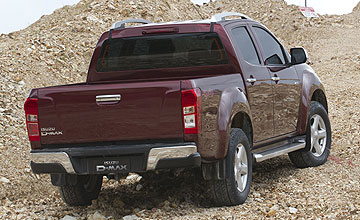BY DAVID HASSALL | 25th Jun 2012

It may not be perfect, and it certainly does not have the profile of the industry’s big guns, but the D-Max is a solid and honest performer that thoroughly deserves its place in an increasingly diverse market.
The D-Max may never scale the sales heights of the Toyota HiLux, Nissan Navara, Mitsubishi Triton, Mazda BT-50 or Ford Ranger, but it is rising steadily in the thoughts of ute buyers.
In fact, it is eyeing off the numbers that Holden enjoyed in years past when it sold the previous model as the Rodeo, which would be quite an accomplishment for the unassuming but impressive staff at Isuzu Ute Australia.
One of the moves designed to increase demand for the latest-generation is the addition of a new top-end four-wheel-drive version called the LS-Terrain, which is clearly designed to appeal to the growing urban off-roader crowd and therefore comes with all the bells and whistles.
Unlike the recently launched and similarly priced Holden Colorado LTZ range-topper the Isuzu flagship comes with leather upholstery, satellite-navigation with a touchscreen, roof rails and a reversing camera that displays the image on the touchscreen.
There is no cosmetic rollover bar mounted behind the cabin like the Colorado, but Isuzu does offer a dealer-fitted unit that looks good, especially matched with (also optional) hard tonneau cover.
The 17-inch alloy wheels look rather dated, especially compared with the Colorado’s, but overall the D-Max looks pleasing to the eye in all variants. Looks are entirely subjective, of course, but to this observer the Isuzu looks better than the Colorado, HiLux and BT-50 despite the wheels.
Of course, the D-Max was developed in conjunction with the Colorado because of the previous cross-ownership with General Motors, but there is no longer any love lost between the former partners and they are now fighting for bragging rights.
There are significant differences between the two vehicles – the engines are completely different, as are the transmissions and the front end forward of the windscreen – but the interior architecture is the same.
Compared to the previous D-Max, the rear seat in the crew cab is angled at a more comfortable 24 degrees – three degrees more – and it is not only comfortable but incredibly spacious with masses of legroom (even with the front seats set back), plenty of headroom and more room for your feet between more widely-set front seat runners.
The leather upholstery – like the rather hard plastics – is clearly designed to be hard-wearing rather than soft and cosseting, but there is no excuse for the brown colour in our otherwise charcoal-interior test vehicle. Even the Isuzu executives looked ashamed and conceded that the colour would likely slide off the menu.
Intriguingly, the top-spec LS-Terrain model’s steering wheel was not only less comfortable to use than the rest of the range, but comes without audio and phone controls, which are standard on a number of lesser models. We’ll spare you the convoluted reasons, but it’s a significant omission for a $50,000-plus vehicle when lower-spec models get it.
Getting comfortable was compromised by the lack of reach adjustment for the steering wheel, which seems an oversight in this day and age, but overall it was comfortable and gave us no pain over a long and testing day behind the wheel.
Build quality seemed to be very good, despite a balky dash-top compartment lid in one vehicle, and after a heavy day of pounding, the test vehicles revealed no squeaks or rattles.
Dynamically, the D-Max scores well on most fronts, starting with well-weighted and direct steering. It was certainly a pleasure dealing with an old-fashioned hydraulic system after most of the modern electric-powered steering systems.
The engine may not produce the peak torque numbers of some rivals, but it has been well-tuned to deliver across a wide rev range and from low down, so it performs acceptably without feeling ‘grunty’.
It is well-matched to a five-speed automatic transmission – perhaps it could have done with six like many rivals – that shifts very smoothly and always seems to be in the right gear.
The real dynamic stand-out, however, is the ride, which is more car-like than any ute we can recall driving, absorbing all manner of road irregularities with great aplomb. Some railway crossings on our test route could barely be felt. It was hard to believe this was a ute, with leaf-sprung rear end and no load in the tray.
Off-road, the D-Max also excelled, tackling some very testing tracks and spitting them out without pausing for breath. Even with a part-time all-wheel-drive system, this ute could hold its own with many more serious off-road wagons on a boys’ weekend.
Interior comfort is excellent for a ute, with well-designed seats, a good basic steering wheel (as mentioned, better than the flagship’s) and height-adjustable seatbelt anchors in the front.
There was a little wind noise from the wide mirrors, as you would expect, but road noise was minimal on the highway, even on coarse road surfaces.
Rocks smacking the inner rear guards created a bit of noise in the new space-cab variant, but we don’t recall hearing this in the crew-cab, even though it is no different in the inner guard area.
Overall, then, the new D-Max greatly impressed us with its presentation and dynamics, leaving only a few question marks over some specification choices such as steering wheel reach adjustment, parking sensors and steering wheel controls.